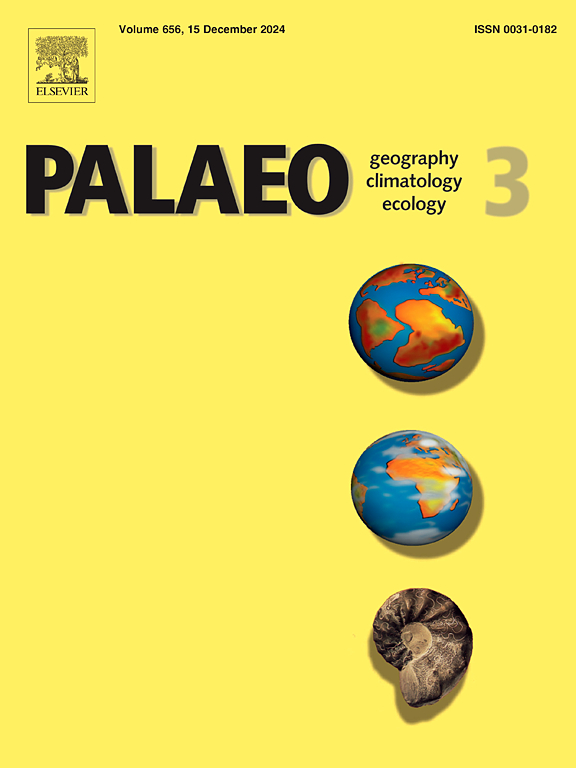Strong coupling between the carbon and nitrogen cycles, environmental change, and organic carbon enrichment during the early–middle Eocene
IF 2.7
2区 地球科学
Q2 GEOGRAPHY, PHYSICAL
Palaeogeography, Palaeoclimatology, Palaeoecology
Pub Date : 2025-07-19
DOI:10.1016/j.palaeo.2025.113145
引用次数: 0
Abstract
The early–middle Eocene constitutes a key stage of the Phanerozoic because it represents the last long-lived greenhouse period in Earth's history. The identification of the mechanisms underlying the associated geochemical carbon and nitrogen cycles can help us understand the environmental effects of global warming during the early–middle Eocene. There is currently notable interest in marine systems, but little is known regarding the geochemical cycling of carbon and nitrogen in lake systems during the early–middle Eocene. To address this problem, we systematically analyzed carbon and nitrogen isotopes in organic-rich lacustrine mudstones of the lower–middle Eocene Wenchang Formation in the Pearl River Mouth Basin (South China). We then determined the paleoclimate disturbances and historical paleoenvironmental information recorded in the sediments and established a conceptual environmental and biogeochemical model of the Wenchang Formation on the basis of the carbon and nitrogen cycles. The carbon isotope data revealed that the geochemical carbon cycle was affected mainly by the concentration of dissolved CO2 and input from chemoautotrophs in lake water and that negative δ13Corg values provide evidence for positive feedback to the warm paleoclimate and high atmospheric pCO2 levels during the early–middle Eocene. Enhanced chemical weathering promoted an increase in primary productivity and intensified the lacustrine reducing environment, thereby forming a feedback loop between productivity and hypoxia. This mechanism driving the warm and humid climate was particularly significant in Units I and III of the Wenchang Formation. With decreasing atmospheric pCO2 level, the positive excursions of δ13Corg suggest the existence of a cooling interval in the climate (during the deposition of Units II and IV). A salinization event led to the occurrence of an anoxic and brackish water column under the influence of a strongly restricted environment during these periods, while the positive excursion of δ15N suggested an increased denitrification rate. The positive excursions of δ15N and δ13Ccarb were significantly associated with increasing total organic carbon (TOC) contents, which suggests that the increase in nitrate concentration was synchronous with the intensification of the lacustrine reducing environment and the increase in bioproductivity. Elucidating the strong coupling among the carbon and nitrogen cycles, environmental changes, and organic carbon enrichment during the early–middle Eocene can provide key constraints for understanding the mechanisms driving the carbon and nitrogen cycles and organic matter enrichment in lakes during the paleoclimate warming period.
始新世早期-中期碳氮循环、环境变化与有机碳富集之间的强耦合
始新世早期至中期是显生宙的关键阶段,因为它代表了地球历史上最后一个长期存在的温室期。确定地球化学碳氮循环的相关机制有助于我们了解始新世早期-中期全球变暖对环境的影响。目前人们对海洋系统的研究兴趣显著,但对始新世早中期湖泊系统碳氮的地球化学循环知之甚少。为了解决这一问题,我们对珠江口盆地始新统下-中文昌组富有机质湖相泥岩的碳氮同位素进行了系统分析。根据沉积物中记录的古气候扰动和历史古环境信息,建立了以碳、氮循环为基础的文昌组环境生物地球化学概念模型。碳同位素数据表明,地球化学碳循环主要受溶解CO2浓度和湖泊水体化能自养生物输入的影响,负δ13Corg值为始新世早期-中期温暖古气候和高大气pCO2水平提供了正反馈证据。化学风化作用的增强促进了初级生产力的增加,强化了湖泊还原环境,形成了生产力与缺氧之间的反馈循环。这一机制对温昌组一段和三段暖湿气候的驱动作用尤为显著。随着大气pCO2水平的降低,δ13Corg的正偏移表明气候存在冷却间隔(在单元II和单元IV沉积期间)。在这些时期,在强烈限制环境的影响下,盐碱化事件导致缺氧和微咸水柱的出现,而δ15N的正偏移表明反硝化速率增加。δ15N和δ13Ccarb的正偏移与总有机碳(TOC)含量的增加呈显著相关,表明硝态氮浓度的增加与湖泊还原环境的增强和生物生产力的提高同步。阐明始新世早期-中期湖泊碳氮循环、环境变化和有机碳富集之间的强耦合关系,可以为理解古气候变暖时期湖泊碳氮循环和有机质富集的驱动机制提供关键约束。
本文章由计算机程序翻译,如有差异,请以英文原文为准。
求助全文
约1分钟内获得全文
求助全文
来源期刊
CiteScore
5.90
自引率
10.00%
发文量
398
审稿时长
3.8 months
期刊介绍:
Palaeogeography, Palaeoclimatology, Palaeoecology is an international medium for the publication of high quality and multidisciplinary, original studies and comprehensive reviews in the field of palaeo-environmental geology. The journal aims at bringing together data with global implications from research in the many different disciplines involved in palaeo-environmental investigations.
By cutting across the boundaries of established sciences, it provides an interdisciplinary forum where issues of general interest can be discussed.

 求助内容:
求助内容: 应助结果提醒方式:
应助结果提醒方式:


